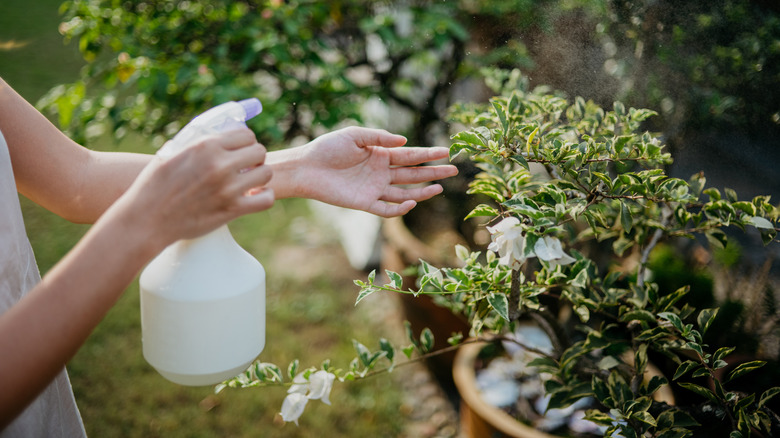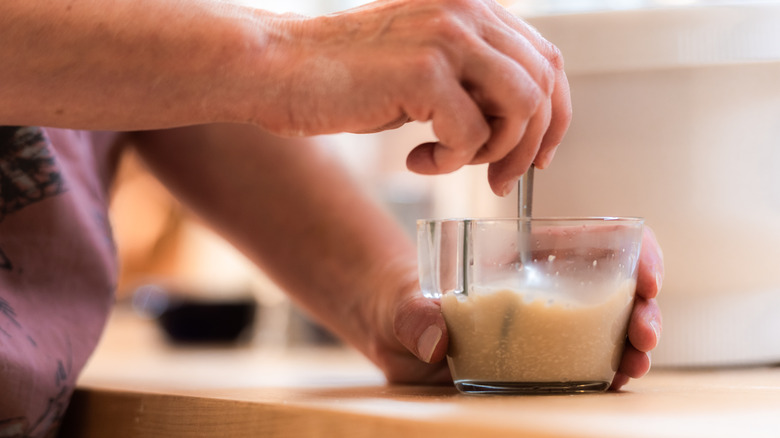The Baker's Ingredient You Should Be Using For Houseplants & In The Garden
The smell of fresh-baked bread and the bubble of cold beer: these are among the sights and sounds you might associate with yeast. But what about the many household applications of yeast, like banishing mosquitoes from your yard, getting rid of spiders, or trapping bed bugs? While you might not picture yeast and garden management in the same frame, there's good reason to, aside from possible pest control.
Common garden fruits and veggies like tomatoes, cucumbers, and strawberries can benefit greatly from the application of yeast. A 2020 study from Agronomy on the interaction between baker's yeast and selenium on tomato plants showed that yeast increases the positive effects and decreases the negative effects of foliar selenium spray, improving photosynthesis and overall plant health. But creating a healthy plant microbiome with yeast goes beyond tomato plants alone, and there are a number of ways you can apply yeast to your home garden to promote plant growth of all kinds.
Why yeast?
What makes yeast so useful to plants? Researchers at The Microbiologist stated that "yeasts are capable of promoting plant growth, right from the tip of the root to the topmost portion of the shoot." In fact, yeasts that promote plant growth have been found to improve nutrient availability in the soil, regulate phytohormones, and fight off harmful microorganisms and blights. As any home fermenter will know, yeasts are adept at colonizing a medium, and essentially, their application to plants is a form of colonization that benefits the host organism (in this case, your garden veggies).
Yeasts are naturally present on plants and in soil, but scientists are also studying the effects of intentionally applying yeasts to crops for improved growth. According to a 2014 study in Crop Science, waste products from breweries were shown to increase nitrogen and phosphorus in the leaves and roots of crops like tomato plants and sugarcane. Spraying a yeast mixture directly on a plant's leaves could prevent fungal infections or mold diseases. The application of yeasts offers a sustainable alternative to chemical fertilizers and pesticides. Yeast can be used both in its fermented and unfermented forms to garner these positive effects, making it a versatile, greener option for garden management.
How to make your own yeast fertilizer or spray
If you'd like to make your own fermented yeast fertilizer, stir 1 ounce of dry yeast with half a cup of warm water, then combine it with 1 cup of sugar and 2 ½ more gallons of warm water in a 3-gallon container to ferment for a week. You can make a quicker, unfermented fertilizer that combines 1 ounce of yeast with 2 ½ gallons of lukewarm water, which can be used an hour after mixing. A 2024 study from Frontiers in Industrial Microbiology on brewer's yeast specifically noted positive effects on seedling germination and growth, so it may make sense to experiment with yeast fertilizer in the early stages of your garden. Simply add it directly to the soil.
But as plants grow and pest and blight problems increase, yeast can also lend an eco-friendly hand as a foliar spray, which means you would spray the leaves directly. For direct usage to a mature plant's foliage, dissolve 1 ounce of dry yeast in 2 cups of whole milk, then add 2 ½ gallons of lukewarm water. You can try adding one or two drops of dishwasher detergent to help the mixture stick. Then, spray your mixture broadly over the plant every week.


